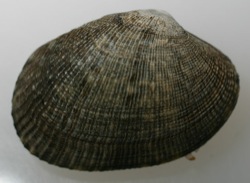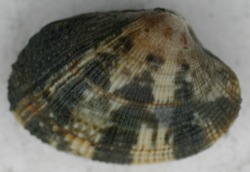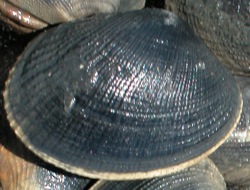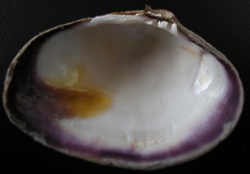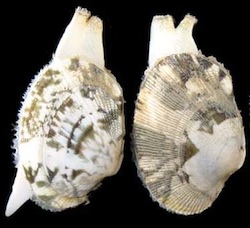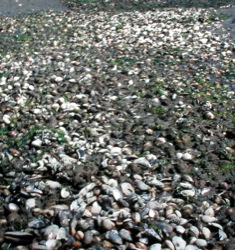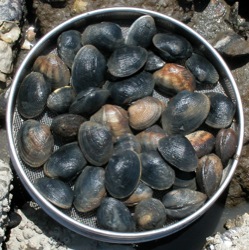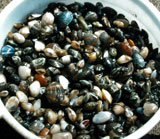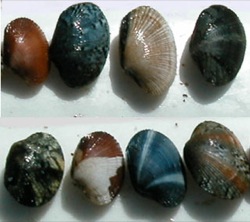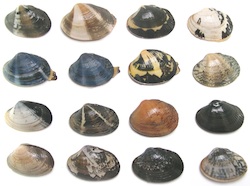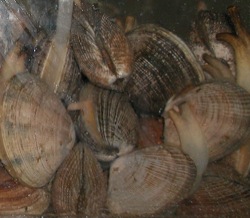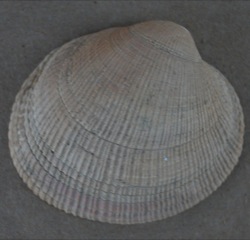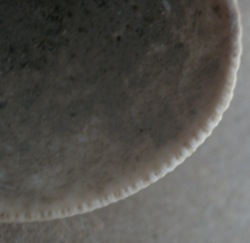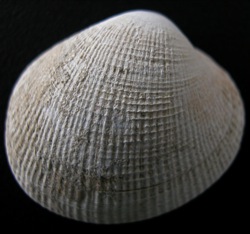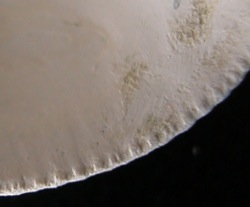Venerupis philippinarum Adams & Reeve, 1850
JAPANESE LITTLENECK CLAM, JAPANESE COCKLE, MANILA CLAM
- Kingdom: Animalia
- Phylum: Mollusca
- Class: Bivalvia
- Subclass: Heterodonta
- Order: Veneroida
- Superfamily: Veneroidea
- Family: Veneridae
Venerupis philippinarum has a thick shell, oval in outline, with a maximum length of about 6 cm. The surface of the shell is sculpted with weak concentric ridges that mark the shell's progressive growth, and more pronounced straight ridges that radiate outward from the center of growth to the shell margins. The umbo—the hump at the center of growth—is at the hinged margin of the shell, about 1/3 of the shell's length away from the head end and angled toward it.
The shell is usually cream or gray, sometimes with green or brown tones, and sometimes stained rusty or black (the latter typical of anoxic mud). It often has patterns of dark brown or black, overlapping, triangular markings that start from points nearer the umbo and widen toward the shell's lower edge. Smaller specimens (up to about 3 cm) found in muddy sand on the east shore of San Francisco Bay come in a remarkable variety of hues, including white, tan, yellow, blue and green, often with darker markings that include the patterns described above, tall black triangles, and intricate patterns of zigzag lines. The interior of the shell is mostly white, often with dark purple or yellow staining near the hind end and the lower margins of the shell.
Water passes in and out of a clam through two tubes, called siphons, that protrude from the hind end of the shell. In Venerupis philippinarum these siphons are fused together along most of their length but are separate at the tips. They are relatively short—earning it the common name of "littleneck clam"—which prevents the clam from burrowing deeply. Venerupis philippinarum occurs in bays and estuaries in the middle to low intertidal zone, in muddy sand, sandy mud and among buried cobbles. I have also frequently found it in the mud inside tires that are hung on the sides of docks as boat bumpers. In its more usual haunts it occurs just beneath the surface of the sediment. It sometimes plows along just under the surface, leaving a grooved track in the sand or mud; often one can find the clam under a slight mound at the end of the track. In San Francisco Bay, larger specimens of Venerupis philippinarum are generally found among buried cobbles, under rocks, or in other protected situations. On the intertidal flats, birds, crabs, snails, bat rays and other predators probably remove these shallowly-buried clams before they can reach large size.
In many bays in the Pacific Northwest, and in Humboldt Bay and Tomales Bay in California, Venerupis philippinarum is grown commercially (often protected under nets or in mesh bags), and sold in markets as the Manila Clam. Around 1,000-1,500 tons of Venerupis philippinarum are harvested in British Columbia each year, about 500 tons (accounting for half of the hard-shell clam harvest) in Washington, and small amounts in Oregon and California. Global aquaculture production of Venerupis philippinarum is estimated at over 1 million tons/year with a value of around $1.5 billion.
Venerupis philippinarum can tolerate salinities down to 10-15 ppt, but grows best at 24-31 ppt and temperatures of 13-21° C. It reaches maturity at a length of 1-2 cm, and can live up to 7-10 years. It requires temperatures above about 14° C to spawn. Its larvae spend 3-4 weeks drifting in the plankton, then settle to the bottom and attach with threads to rocks or shells.
A variety of organisms have been observed feeding on Venerupis philippinarum on the Pacific coast, including the moon snail Euspira lewisii, the Atlantic oyster drill Urosalpinx cinerea, crabs, bat rays, flounder, sturgeon, willet, gulls, ducks and raccoons, and undoubtedly many others. The small pea crabs Pinnixa faba and Pinnixa littoralis are sometimes found living inside the shells of live Venerupis philippinarum.
Similar Species
On the Pacific Coast, Venerupis philippinarum is most likely to be confused with clams in the genera Protothaca and Chione whose shell surfaces are sculpted by both radiating and concentric ridges. In Chione species, which are mainly found in southern California and Baja California, the outline of the shell is more circular than oval, and in some species the concentric ridges are considerably more pronounced than the radiating ridges. Protothaca laciniata, which ranges from Monterey Bay to Baja California, is also nearly circular in outline, the concentric and radiating ridges are equally pronounced, and there are small spines (which may be missing in worn specimens) at the intersections of these ridges.
Protothaca staminea, which ranges from the Aleutian Islands to Baja California, is probably the most difficult Pacific Coast species to distinguish from Venerupis philippinarum. It is oval, though not as long an oval as Venerupis, and like Venerupis, the radiating ridges are stronger than the concentric ones. However, Protothaca staminea has a row of small "teeth" just inside the rim of the shell, which are not present in Venerupis philippinarum, and its siphons are fused for their entire length and not separated at the tips. It grows a little larger than Venerupis philippinarum, and is found on the outer coast as well as in bays. In bays that have both species, Protothaca staminea is generally found a little lower in the intertidal zone and buried a little deeper than Venerupis philippinarum,
Native Range
Japan, Korea and China, with natural range expanded by cultivation.
Introduction and Distribution on the Pacific Coast [with dates of first record]
- British Columbia: Hecate Strait [collected in 1972], Quatsino Sound [by 1971], Esperanza Inlet [1950s], Barkley Sound [1950s], Strait of Georgia and southeastern Vancouver Island from Cortes Island to Saanich Inlet [first collected at Ladysmith Harbor in 1936], Boundary Bay [collected in 1976]
- Washington: Puget Sound [reported in 1943], Gray's Harbor [reported in 1964], Willapa Bay [collected in 1946]
- Oregon: Netarts Bay [planted in 1965]
- California: Humboldt Bay [reported in 1964], Bodega Harbor [collected in 1949], Estero Americano [collected in 1977], Tomales Bay [collected in 1954], Bolinas Lagoon [collected in 1966], San Francisco Bay [collected in 1946], Elkhorn Slough [collected in 1949], Port Hueneme [collected in 2000-2001]
- Baja California: Bahía de San Quintín [reported in 1987]
The first record of an established population of Venerupis philippinarum in North America is at Ladysmith Harbor on the eastern shore of Vancouver Island, British Columbia in 1936. Drifting larvae appear to be responsible for Venerupis philippinarum's spread northward from Ladysmith Harbor in Georgia Strait and southward on Vancouver Island, and its later spread from Barkley Sound on the west side of Vancouver Island northward to Hecate Strait. However, the clam's spread across Vancouver Island to Barkley Sound and southward to various sites in Washington, Oregon, California and Baja California is probably due primarily to transplanting of oysters or intentional transplants (recorded or unrecorded) of Venerupis philippinarum along the coast, with possibly a few independent introductions in oyster shipments from Japan. Though it was introduced accidentally, it was harvested and sold in markets on the Pacific Coast as early as 1941.
Venerupis philippinarum was reported in oyster beds in Samish Bay, Washington in 1924, and in a shipment of Japanese oysters at Elkhorn Slough, California in 1930, though neither of these records seems to have led directly to established populations. Efforts were made to establish Venerupis philippinarum in Morro Bay, Newport Harbor and the Salton Sea in California 1953, in the Queen Charlotte Islands in British Columbia in 1962, in Yaquina and Tillamook bays in Oregon in 1965, and in Coos Bay in 1987, all of which failed.
Today, Venerupis philippinarum is one of the most common benthic organisms in San Francisco Bay, where it has been found from the uppermost reaches of Suisun Bay near Browns Island to the south end of the South Bay, and nearly to the Golden Gate. It is commonly found at concentrations up to 2,000 clams per square meter from San Pablo Bay to the South Bay. It is collected non-commercially in the bay for both food and bait.
Additional Global Distribution [with dates of first record]
Venerupis philippinarum was repeatedly planted on Oahu, Hawaii by residents from Japan. Populations may have become established as early as the late 1880s, and were clearly established by 1918 when they were collected from the shore and also offered for sale in Honolulu fish markets. In 1937, clams from Oahu were planted on most of the other Hawaiian islands. Venerupis philippinarum was also introduced for farming on the French Atlantic coast [established in the wild since the 1980s] and French Mediterranean coast [planted in the Thau Lagoon at Languedoc in 1980]; and in Italy in the Venice lagoons [planted in 1983] and the Po River delta [planted in 1986]; and is now also present in Romagna and Sardinia in Italy. It has been cultured in England but is not established there.
Other names that have been used in the scientific literature
Tapes philippinarum, Ruditapes philippinarum, Venus philippinarum, Tapes japonica, Tapes semidecussata, Paphia bifurcata, Tapes quadriradiatus, Tapes violascens
Literature Sources and Additional Information
Carlton, J.T. 1979. History, Biogeography, and Ecology of the Introduced Marine and Estuarine Invertebrates of the Pacific Coast of North America. Ph.D. thesis, University of California, Davis, CA (pp. 502-513).
Cohen, A.N. and J.T. Carlton. 1995. Nonindigenous Aquatic Species in a United States Estuary: A Case Study of the Biological Invasions of the San Francisco Bay and Delta. U.S. Fish and Wildlife Service, Washington, DC (pp. 72-73).
Emmett, R.L., S.A Hinton, S.L. Stone and M.E. Monaco. 1991. Distribution and Abundance of Fishes and Invertebrates in West Coast Estuaries. Volume II: Species Life History Summaries. ELMR Report No. 8, National Oceanic and Atmospheric Administration/National Ocean Service, Rockville, MD (pp. 44-48).
Morris, R.H., D.P. Abbott and E.C. Haderlie. 1980. Intertidal Invertebrates of California. Stanford University Press, Stanford, CA (p. 375).
Websites
Canadian Science Advisory Secretariat - Publications
http://www.dfo-mpo.gc.ca/CSAS/CSAS/status/1999/c6-03e.pdf
CIESM - Atlas of Exotic Species in the Mediterranean
http://www.ciesm.org/atlas/Ruditapesphilippinarum.html
Washington Department of Fish and Wildlife - Shellfish
http://www.wdfw.wa.gov/fish/shelfish/beachreg/1clam.htm
Rosario Beach Marine Laboratory: Invertebrates of the Salish Sea
http://www.wallawalla.edu/academics/departments/biology/rosario/inverts/Mollusca/Bivalvia/Veneroida/Veneridae/Venerupis_philippinarum.html

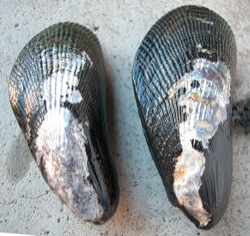 Geukensia demissa
Geukensia demissa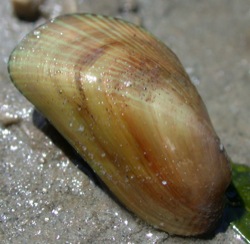 Musculista senhousia
Musculista senhousia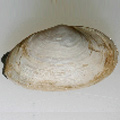 Mya arenaria
Mya arenaria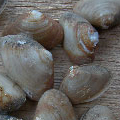 Corbula amurensis
Corbula amurensis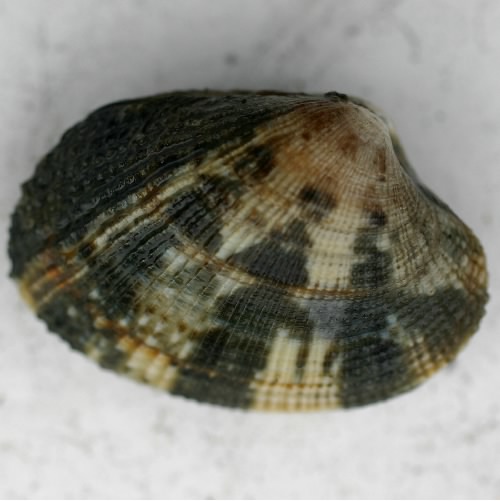 Venerupis philippinarum
Venerupis philippinarum